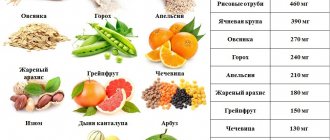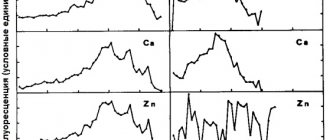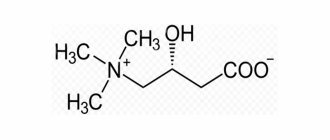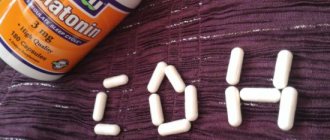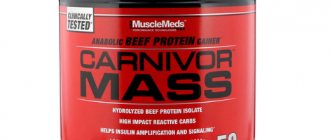Asparkam is a drug that helps normalize the electrolyte balance of the body. At the same time, it replenishes the body with magnesium and potassium. It is prescribed for heart failure and as a preventative against stroke. It is effective for muscle cramps.
Asparkam is used in bodybuilding to normalize heart rate. Heart rhythm disturbances are observed as a result of increased physical activity.
Asparkam[edit | edit code]
Yuzhakov Anton Description of Asparkam from 3.14 min
Packaging varies depending on the manufacturer Asparkam from Pharmapol-Volga Asparkam from Renewal Asparkam-L (injection solution)
Asparkam
(international name: potassium and magnesium aspartate) is a medicine for quickly replenishing potassium and magnesium deficiency in the body and normalizing electrolyte balance.
It also contains aspartate (aspartic acid), a carrier of these ions across cell membranes. Does not have
an anabolic effect .
It is used for heart rhythm disturbances, coronary heart disease (angina) and for the prevention of stroke. Often prescribed for the development of muscle cramps.
Price
asparkam 40-120 rubles per package.
Analogues:
more expensive Panangin from GEDEON RICHTER. No advantages over asparkam have been proven in studies.
Best before date.
3 years.
Storage conditions:
in a dry place at a temperature not exceeding 25 °C.
Keep out of the reach of children. Packaging
of 50 tablets in a blister;
50 tablets in a blister, 1 blister in a pack. Dispensing category
: without prescription.
Composition of dosage forms[edit | edit code]
Pills
(have a specific smell):
- Active ingredients: 1 tablet contains magnesium aspartate 175 mg (0.175 g), potassium aspartate 175 mg (0.175 g);
- Excipients: corn starch, polysorbate-80, calcium stearate, talc.
Injection
:
- Active ingredients: 1 ml of solution contains anhydrous magnesium aspartate 40 mg (3.37 mg magnesium), anhydrous potassium aspartate 45.2 mg (10.33 mg potassium);
- Excipients: sorbitol (E 420), water for injection.
How to take the drug?
Above we figured out why it is recommended to drink asparkam. Now let's look at how to take it correctly. The drug is available in two main forms - tablets and injections. Taking injections is a rare occurrence. The main reason is inconvenience and a high risk of overdose (hyperkalemia)
In the case of tablets, maintaining the dosage is not a problem. Here, 1-2 tablets per day after meals are enough. However, increasing the daily dosage does not add any effect. The body will take everything that it lacked and remove the rest from the body through urine.
To take it in liquid form, the composition must be prepared. So, 20 ml of the drug is diluted in 150-200 ml of 0.9 percent sodium chloride (a 0.5 percent glucose solution can be used). Dosage for adults – 10-20 ml of the composition 1-2 times a day. In this case, the rate of administration must be strictly controlled. As a rule, it is 25 drops per minute. It is allowed to use only transparent compounds and immediately after opening. Adding medicinal solutions to asparkam is prohibited.
The average duration of treatment required to cover all reserves is about a month. Taking asparkam is often tied to periods of active training. So, at the beginning of difficult weeks (work on gaining weight or burning fat), you can supplement the diet with such an important supplier of potassium and magnesium.
As practice shows, the course of admission may vary. The average is a month, but a more precise duration is determined taking into account individual characteristics. Here you need to look at the effectiveness of the training and general condition. If there are any deviations (will be listed below), it is better not to rush into taking it, but to consult a doctor.
Action[edit | edit code]
Asparkam is a medicine that regulates metabolic processes. The mechanism of action is associated with the role of aspartates to transport magnesium and potassium ions into the intracellular space and their participation in metabolic processes. Asparkam eliminates electrolyte imbalance, magnesium and potassium deficiency, reduces myocardial excitability and conductivity, exhibits a moderate antiarrhythmic effect, improves metabolism in the myocardium and coronary circulation, and also reduces the sensitivity of the myocardium to cardiac glycosides and the manifestations of their toxicity. Mg2+ ions activate Na+, K+-ATPases. In this connection, the intracellular concentration of Na+ ions decreases and the flow of K+ ions into the cells increases. When the concentration of Na+ ions inside the cell decreases, the exchange of Na+ and Ca2+ ions in the smooth muscles of blood vessels is inhibited, which leads to their relaxation. K+ ions stimulate the synthesis of ATP, glycogen, proteins, and acetylcholine. K+ and Mg2+ ions support the polarization of cell membranes. Aspartate is a carrier of K+ and Mg2+ ions and promotes their entry into the intracellular space. Once in the cell, aspartate is also involved in metabolic processes, promotes the synthesis of amino acids, amino sugars, nucleotides, nitrogen-containing lipids, and corrects disturbances in the energy metabolism of ischemic myocardium.
It is quickly and completely absorbed and excreted mainly by the kidneys. The concentration of potassium and magnesium in the blood reaches a maximum 1-2 hours after taking the drug. From the blood, the drug enters cardiomyocytes in the form of K+, Mg2+, and aspartate ions and is included in cellular metabolism.
Asparkam in bodybuilding and strength sports
Content
“Asparkam” for athletes with heavy physical activity is highly effective and practical.
Main effects of the drug:
- relieves or eliminates cramps;
- relieves severe fatigue;
- prevents and promotes recovery of the athlete from a state of overtraining;
- improves well-being during long-term stay on a strict diet;
- stimulates muscle development.
“Asparkam” in bodybuilding is especially important for increasing muscle mass, because magnesium contained in the drug is involved in protein metabolism and the process of transferring energy to muscles.
Asparkam is a drug that helps normalize the electrolyte balance of the body.
According to scientific research, when consuming magnesium and potassium, an athlete’s strength increases, he is able to lift more weight in strength training, but the effect is short-lived, and endurance practically does not develop from taking it. Researchers have found a large increase in strength, with some athletes being able to increase it by 50%.
In the process of other scientific work, the composition with the addition of aspartic acid, which is contained in Asparkam, was considered. The test subjects showed an increase in endurance indicators, but the results did not differ much; accordingly, a sufficient level of influence on endurance has not yet been established.
When losing weight, “Asparkam” allows you to replenish the deficiency of nutrients in the body caused by a strict diet. Due to a lack of minerals and vitamins, convulsions and other abnormalities in the functioning of the central nervous system often appear; they can be easily eliminated by drinking Asparkam.
Many athletes are faced with “clogging” of the main muscle groups, which is what they use the drug to prevent. Athletes who use anabolic steroids are especially at risk.
Indications for use[edit | edit code]
- as part of complex therapy for heart failure, conditions after myocardial infarction, heart rhythm disturbances (mainly ventricular arrhythmias) caused by electrolyte disturbances;
- to enhance the effectiveness and improve the tolerability of cardiac glycosides;
- in conditions accompanied by hypokalemia and hypomagnesemia (including overdose of saluretics).
Recommendations for use in sports[edit | edit code]
- Prolonged intense physical activity.
- Maladjustment (overtraining). As an auxiliary therapeutic agent.
- Cardiopsychoneurosis.
- Heart rhythm disturbances.
Reviews
Having analyzed the reviews about asparkam, a mixed opinion emerges. The main thing that attracts is the affordable price of the drug and its effectiveness. At the same time, there are also people who have no idea why the supplement is needed and what benefits it can bring.
The most common mistake is that many people consider asparkam to be an ordinary “vitamin” and do not take it seriously. In fact, this is not so. Incorrect and irregular intake can lead to serious problems in the body.
When used correctly, the drug does not cause any problems and is well tolerated by the body. As for its effectiveness, it is very difficult to prove it due to the lack of obvious manifestations.
Contraindications[edit | edit code]
- Hypersensitivity to the components of the drug;
- acute and chronic renal failure;
- Addison's disease;
- hyperkalemia, hypermagnesemia;
- atrioventricular block II-III degree;
- cardiogenic shock (BP<90 mmHg).
Appropriate safety precautions for use. With prolonged use of the drug, it is necessary to monitor the level of potassium and magnesium in the blood, and regular monitoring of electrolyte hemostasis and ECG data is also necessary.
Side effects[edit | edit code]
Adverse reactions develop very rarely:
- from the digestive tract: nausea, vomiting, diarrhea, abdominal pain, discomfort or burning sensation in the epigastric region, gastrointestinal bleeding, ulcers of the mucous membrane of the digestive tract, dry mouth;
- from the cardiovascular system: impaired myocardial conduction, decreased blood pressure, AV block;
- from the central and peripheral nervous system: paresthesia, hyporeflexia, convulsions;
- allergic reactions: itching, redness of the facial skin, rash;
- from the respiratory system: possible respiratory depression (due to hypermagnesemia);
- others: feeling of heat.
Interaction with other drugs and other types of interactions.
Due to the presence of potassium ions in the drug, when Asparkam is used with potassium-sparing diuretics, ACE inhibitors, beta-blockers, cyclosporine, the risk of developing hyperkalemia increases (control of the level of potassium in the blood plasma is necessary) and the inhibitory effect on intestinal motility increases.
The drug inhibits the absorption of oral forms of tetracycline, iron salts and sodium fluoride (it is necessary to adhere to a three-hour interval between doses).
Asparkam enhances the effect of drugs that stimulate trophic processes in the myocardium; prevents the development of hypokalemia caused by the use of saluretics, corticosteroids, cardiac glycosides. Asparkam reduces the cardiotoxic effect of cardiac glycosides.
When used simultaneously with antidepolarizing muscle relaxants, the neuromuscular blockade is enhanced, and with anesthetic agents (ketamine, hexanal, fluorothane, etc.) the central nervous system is depressed. Asparkam may reduce the effectiveness of neomycin, polymyxin B, tetracycline and streptomycin.
Overdose.
At the moment, no cases of overdose have been registered.
Asparkam instructions for use
Diacarb and Asparkam for infants reviews Komarovsky
What else is the medicine used for, what harm and benefits does it have, is it possible to take asparkam and diacarb together, is there any effect in treating children? In medicine, a combination of asparkam and diacarb is often used to treat infants. Komarovsky is skeptical about diseases based on increased intracranial pressure. He says that it can only be measured by analyzing a spinal tap, as well as by performing appropriate brain surgery.
He considers congenital hydrocephalus, encephalitis, meningitis, and surgical operations after acquired or birth injuries to be justified reasons for treatment with diacarb.
He pays special attention to the fact that intracranial pressure can be cured with medications during the first 2 months; if there is no effect from complex therapy, medication is replaced by massages, physiotherapy and other procedures. The regimen for taking asparkam and diacarb is appropriate only for confirmed diagnoses
How to take during pregnancy?
Is asparkam good for pregnant women, how to give it? The annotation states that in the first trimester of pregnancy you should refrain from taking the medicine
In the second and third, it is recommended to exercise caution; it must be taken into account that an overdose of any substance in the body can cause harm. Self-medication is unacceptable; the doctor prescribes therapy based on symptoms
For weight loss
The opinions of many experts about the appropriateness of the drug for weight loss differ; many point out the dangers of using medications for the purpose of weight loss. Despite this opinion, patients continue to use medications to lose weight.
In sports, in bodybuilding
The description states that asparkam is recommended to be taken only as prescribed by a doctor; in sports and bodybuilding it is used for cutting; the standard dosage is 1-2 tablets three times a day after meals. The duration of treatment is determined by the doctor; the full course usually lasts a month.
For prevention, dosage regimen
Asparkam can also be used for prevention, in order to maintain normal condition. How to drink correctly? The adult dose (2 tablets, 3 times a day) is reduced in this case to 1 tablet. the course lasts a month.
Asparkam avexima instructions for use
What is the dosage regimen and how long to treat? Dosage for adults depends on the diagnosis; it must be taken according to a doctor’s prescription; the standard dose is 2 tablets three times a day.
Analogs
Does the drug have analogues, can it be replaced? The following similar drugs are sold in pharmacies: avexima, clenbuterol, furosemide, riboxin, orotate, farmak, glutamic acid, glycine, retinol, cardiomagnyl, diacarba, fezam, glycoside, furosemide.
What is the difference between Asparkam and Panangin?
What is the difference between Panangin and Asparkam, are they the same thing, how do they differ, what are the differences in comparison? The chemical composition is almost identical, the only difference is the dosage form. Asparkam is available in tablets, Panangin - in film-coated tablets. Panangin is prescribed for peptic ulcers, since the membrane protects the internal organs from the action of the active substance. Both drugs have contraindications.
Contraindications, how long can I take it?
Failure to comply with the dosage can lead to side effects, one of them is hyperkalemia, which manifests itself in the form of arrhythmia, weakness, and even cardiac arrest. Other side effects include flatulence, diarrhea, vomiting, thrombophlebitis, decreased heart rate, stomach and intestinal bleeding. In addition, the breathing process becomes difficult, blood pressure decreases, dizziness and weakness occur.
Contraindications:
- severe forms of myasthenia;
- excess magnesium and potassium;
- renal failure.
Rapid administration during intravenous use may cause negative consequences. Can it be taken simultaneously with alcohol? Compatibility with alcohol is poor.
